
The Capitol Limited is a daily Amtrak train between Washington, D.C., and Chicago, running 764 miles (1,230 km) via Pittsburgh and Cleveland. Service began in 1981 and was named after the Baltimore and Ohio Railroad's Capitol Limited which ended in 1971 upon the formation of Amtrak. It carries the Amtrak train numbers 29 and 30, which were previously assigned to the discontinued National Limited.
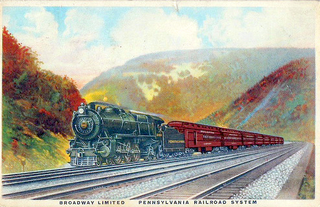
The Broadway Limited was a passenger train operated by the Pennsylvania Railroad (PRR) between New York City and Chicago. It operated from 1912 to 1995. It was the Pennsylvania's premier train, competing directly with the New York Central Railroad's 20th Century Limited. The Broadway Limited continued operating after the formation of Penn Central (PC) in February 1968, one of the few long-distance trains to do so. PC conveyed the train to Amtrak in 1971, who operated it until 1995. The train's name referred not to Broadway in Manhattan, but rather to the "broad way" of PRR's four-track right-of-way along the majority of its route.

The Super Chief was one of the named passenger trains and the flagship of the Atchison, Topeka and Santa Fe Railway. The streamliner claimed to be "The Train of the Stars" because of the various celebrities it carried between Chicago, Illinois, and Los Angeles, California.
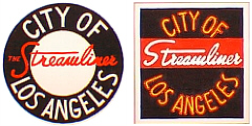
The City of Los Angeles was a streamlined passenger train between Chicago, Illinois, and Los Angeles, California via Omaha, Nebraska, and Ogden, Utah. Between Omaha and Los Angeles it ran on the Union Pacific Railroad; east of Omaha it ran on the Chicago and North Western Railway until October 1955 and on the Milwaukee Road thereafter. The train had number 103 westbound and number 104 eastbound.

The Capitol Limited was an American passenger train run by the Baltimore and Ohio Railroad, originally between New York City and Grand Central Station in Chicago, Illinois, via Union Station, Washington, D.C., Baltimore and Pittsburgh. For almost 48 years, it was the B&O's flagship passenger train, noted for personalized service and innovation. At the time of its discontinuation on May 1, 1971, when Amtrak took over most rail passenger service in the U.S., the Capitol Limited operated between Washington and Chicago.
A lounge car is a type of passenger car on a train, in which riders can purchase food and drinks. The car may feature large windows and comfortable seating to create a relaxing diversion from standard coach or dining options. In earlier times, a lounge car was more likely to have a small kitchen, or grill and a limited menu. Food was prepared to order and often cooked, though items such as club sandwiches would have usually been part of the offerings. The cars were often operated by the Pullman Company, and in other cases by the railroad directly as part of the dining car department.

The City of San Francisco was a streamlined through passenger train which ran from 1936 to 1971 on the Overland Route between Chicago, Illinois and Oakland, California, with a ferry connection on to San Francisco. It was owned and operated jointly by the Chicago and North Western Railway (1936–55), Chicago, Milwaukee, St. Paul and Pacific Railroad (1955–71), the Union Pacific Railroad, and the Southern Pacific Railroad. It provided premium extra fare service from Chicago to San Francisco when introduced in 1936 with a running time of 39 hours and 45 minutes each way.

The Columbian was a named passenger train operated by the Baltimore and Ohio Railroad. It was the all-coach supplemental train of the all-Pullman Capitol Limited. It operated from 1931 to 1964. The train's initial route was between Jersey City, New Jersey and Washington, D.C., but in 1941 the Columbian route was lengthened to Jersey City – Chicago, Illinois. It was the first air-conditioned train in the United States.

The Cincinnatian was a named passenger train operated by the Baltimore and Ohio Railroad (B&O). The B&O inaugurated service on January 19, 1947, with service between Baltimore, Maryland and Cincinnati, Ohio, carrying the number 75 westbound and 76 eastbound, essentially a truncated route of the National Limited which operated between Jersey City, New Jersey and St. Louis.

The George Washington was a named passenger train of the Chesapeake and Ohio Railway running between Cincinnati, Ohio and Washington, D.C. A section divided from the main train at Gordonsville, Virginia and operated through Richmond to Phoebus, Virginia. From the west, a section originated in Louisville and joined at Ashland. The train began service in 1932 to mark the 200th anniversary of the birth of the first president of the United States.

The Southerner was a streamlined passenger train operated by the Southern Railway in the United States between New York City and New Orleans via Charlotte, Atlanta and Birmingham. It operated from 1941 to 1970.

The Metropolitan Special was the workhorse passenger train of the Baltimore and Ohio Railroad (B&O) during the 1920s–1960s between St. Louis, Missouri, and New York's Rockfeller Center station.
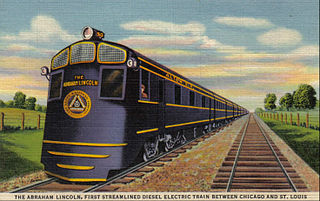
The Abraham Lincoln was a named passenger train operated by the Baltimore and Ohio Railroad from 1935 into the 1960s. The "Abe Lincoln" ran between Chicago and St. Louis on the B&O's subsidiary Alton Railroad. The train later passed to the Gulf, Mobile and Ohio Railroad, and then finally to Amtrak, which retained the name until 1978. Service between Chicago and St. Louis is now known by the umbrella term "Lincoln Service". This train was the first streamlined passenger service to travel the 284 miles between Chicago and St. Louis, with Joliet, Bloomington-Normal, Springfield and Alton in between. Passengers can get a glimpse of the Mississippi River between Alton and St. Louis.
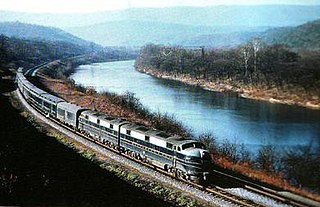
The Shenandoah was an American named passenger train of the Baltimore and Ohio Railroad (B&O), one of four daily B&O trains operating between Jersey City, New Jersey and Grand Central Station in Chicago, Illinois, via Washington, D.C. and Pittsburgh, Pennsylvania from the 1930s to the 1950s. Other B&O trains of that period on the route were the Capitol Limited, Columbian, and the Washington–Chicago Express. An alternate branch originated in Detroit and met with the Chicago part of the train at Deshler, Ohio, south of Toledo.
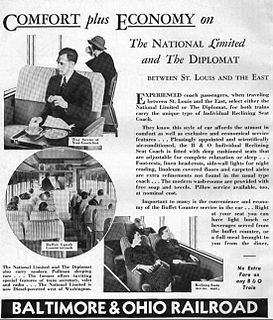
The Diplomat was a named passenger train of the Baltimore and Ohio Railroad (B&O) during the 1930s–1950s connecting New York City and St. Louis, Missouri, via Washington, D.C. Other B&O trains on the route during that period were the premier National Limited and the workhorse Metropolitan Special. The train was inaugurated in August 1930 after several changes to trains along the St. Louis Route. After World War II, the Diplomat operated as Train No. 3 westbound, and No. 4 eastbound. It was timed to provide connections to several western railroads that terminated in St. Louis, including the Frisco, the Santa Fe, Cotton Belt and Missouri Pacific, among others.
The Lake Shore Limited was a passenger train service operated by the New York Central Railroad between New York City and Chicago, Illinois, from 1897 to 1956. Separate sections linked to Boston and St. Louis. The Lake Shore Limited was the New York Central's first luxury passenger train, and paved the way for its more famous cousin the 20th Century Limited. The 1897 name is now used by Amtrak's Lake Shore Limited, which follows much the same route.

The Strata-Domes were a fleet of five streamlined dome cars operated by the Baltimore and Ohio Railroad ("B&O"). The term referred both to a pair of dome cars constructed by Pullman-Standard and three Budd Company domes the B&O acquired from the Chesapeake and Ohio Railway ("C&O"). They were the first dome cars operated in the Eastern United States, following on the success of the Chicago, Burlington and Quincy Railroad's "Vista-Domes" in the west. The cars entered service in 1949 and were all out of regular service by 1981. Several have been preserved.

The Erie Limited was a streamlined passenger train operated by the Erie Railroad between Jersey City, New Jersey and Chicago, Illinois via the Southern Tier. It operated from 1929 to 1963. After the merger of the Erie and the Delaware, Lackawanna and Western Railroad (DL&W) in 1960 it was known as the Erie-Lackawanna Limited. Once the premier passenger train on the Erie, repeated service reductions in the 1950s and 1960s left it a shell of its former self. The Phoebe Snow replaced it in 1963.
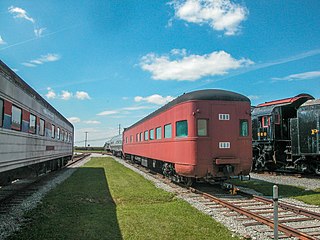
The View series was a fleet of six sleeper-observation lounges built by Pullman-Standard for use on the Pennsylvania Railroad's passenger trains. Pullman built four in 1938 and another two in 1949, after World War II. Their most prominent assignment was on the Broadway Limited, the Pennsylvania's flagship New York–Chicago train, but they were also assigned to the General and the Liberty Limited. Several of the cars have been preserved.

The Liberty Limited was a named train on the Pennsylvania Railroad. It ran from Washington D.C. to Chicago, Illinois, through Baltimore, Harrisburg and Pittsburgh. It began running on September 27, 1925, as a replacement for the Washington–Broadway Limited, which had been introduced in 1923. It originally was scheduled to complete its route in 19 hours.




















